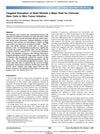The study used Krt1‐15CrePR1;R26R transgenic mice to investigate the role of keratin 15+ cells from hair follicles in skin tumor development, specifically squamous papillomas. It was observed that keratin 15 expressing cells contributed to most papillomas within 20 weeks of promotion and persisted in these tumors for months, unlike their transient role in wound healing. Additionally, papillomas exhibited cellular heterogeneity and about 30% of keratin 15-derived regions expressed the codon 61 Ha-ras mutation, indicating that these cells played a significant role in the development and persistence of cutaneous papillomas, with some expressing mutations typical of initiated cancer cells.
 49 citations
,
October 2009 in “Cancer research”
49 citations
,
October 2009 in “Cancer research” Disrupting Stat3 in hair follicle stem cells greatly reduces skin tumor formation.
207 citations
,
July 2006 in “Development” The study identified a novel population of murine follicular keratinocytes marked by the cell-surface marker MTS24, which exhibited characteristics of progenitor cells. These MTS24-positive keratinocytes were located between sebaceous glands and the hair follicle bulge and were distinct from bulge stem cells. They demonstrated high proliferative potential, forming large colonies more efficiently than other keratinocyte populations, and had a gene expression profile similar to bulge stem cells. The research suggested that MTS24 could serve as a marker for identifying progenitor keratinocytes with significant proliferative capacity, contributing to hair follicle regeneration and repair. This finding had potential implications for understanding hair growth and developing therapeutic applications for hair loss conditions such as alopecia.
1279 citations
,
November 2005 in “Nature Medicine” 561 citations
,
April 2003 in “Journal of Investigative Dermatology” 153 citations
,
April 1998 in “Current Biology” The risk of skin tumors becoming malignant depends on the specific skin cell type affected.
50 citations
,
July 2008 in “British Journal of Dermatology” 138 citations
,
March 2007 in “Experimental cell research” Only a few hair-specific keratins are linked to inherited hair disorders.
276 citations
,
January 2005 in “International review of cytology” 199 citations
,
January 2004 in “The International Journal of Developmental Biology” The document reviewed the advancements in understanding hair follicle differentiation and regulation since Hardy's 1992 review. It covered the structure of hair and hair follicles, the characterization of genes for keratin and keratin-associated proteins, and the identification of their expression locations within different cell layers of the hair follicle. Additionally, it discussed the molecular signals that controlled keratin gene expression and the post-translational events occurring in the terminal stages of hair formation.
29 citations
,
April 2003 in “Experimental dermatology” Human hair follicles grown in vitro maintain normal keratin patterns and structure.
